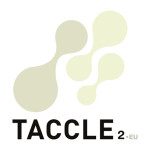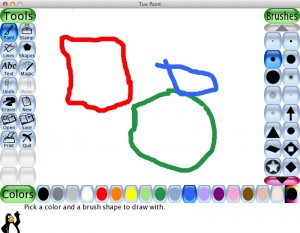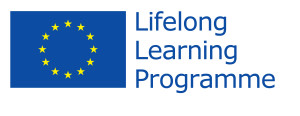Ease *****
Overview
Early on, Learners develop a positive attitude towards ICT and begin to use ICT as a learning aid. Learners will learn to use ICT in a safe, responsible and functional way. Picture dictation can be used with learners of very different ages. It’s a good activity for the memory, concentration, learning mathematical concepts, colours,… and it’s fun!
Description:
There are different ways of doing this, depending on the age group/ability level. A nice program to use is Tux Paint (colours, shapes, stamps, background).
- Give learners a simple drawing that they have to copy using Tux Paint
- Dictate images: big tree, yellow triangle, three apples in a basket, four flowers arranged from smallest to biggest, … left from…, … behind…,… This way the children can learn and practise vocabulary and meaning, learn to stay focused and if you dictate a few things at a time, it can help train their memory.
- Make pairs, put them back to back, one child gets an image and has to explain this image so his colleague can make this drawing (exactly the same) in Tux Paint, this is also a good exercise for communication skills, with older children you can put in lots of mathematical concepts, shapes, properties of shapes etc.
What do I need?
Tux Paint (tuxpaint.org)
Added value:
- learning the basics of language and developing early IT skills e.g. controlling a mouse.
- easily differentiated according to age/ability
- develops listening skills
Hints and tips
This is usually done with one pupil at a time. But you could do it on the interactive whiteboard and ask individuals to come in turn to add to the composition. Alternatively, it could work in pairs, with one instructing the other.
Safety
Even if you publish learners’ work to the web or the school’s website, there are no serious safety implications. If you wish, use only first names on learners’ published work.
Other opportunities to use the same software
- Dictate simple instructions in a foreign language e.g. Faites un dessin d’une fleur rouge
- Create an aerial plan of the classroom/their bedroom.
This post is also available in: Dutch, German, Italian, Spanish, Portuguese (Portugal), Romanian, Welsh





 English
English Nederlands
Nederlands Deutsch
Deutsch Italiano
Italiano Español
Español Português
Português Română
Română Cymraeg
Cymraeg
We tested this exercise with 4-5-6-year-olds in a school in Antwerp.
The toddlers thought the program was really cool. Drawing simple objects went quite well. (Before you start, you do have to practice their IT skills e.g. controlling a mouse. Especially the youngest toddlers are not too familiar with this.)
Drawing a certain number of objects on paper is possible. However, in Tux Paint this is harder to do because they haven’t done this very often. On paper they have more control of their pencil… in Tux Paint they often ‘twitch’ their mouse and an apple does not turn out to be as round or as little as they wanted it to be. They really regret this.
This explains why most of the assignments have not been a real success.
The free game, on the other hand, went really well. The toddlers fully discovered all the program’s possibilities. Additionally, I also gave them a few task cards, asking them to create certain forms (with the help of a phased plan).
I know what you mean about their frustration in not being able to control the mouse. There are a couple of things I have tried.
Try adjusting the speed of the mouse on the settings on your computer to see which works best.
Show children to draw ‘from the middle’. So instead of seeing everything as ‘outlines’, you can build an apple by making a blob or dot and gradually making it bigger until you are happy with the shape of it. For some reason, children find this quite satisfying once they get the hang of building solid shapes rather than linear ones.
Get them drawing a lot on the smart board using the mouse, pens, fingers – whatever the capabilities of your board are. Exploring the sensation of different tools and learning to control digital devices are all part of the IT skills they will need to develop.
Spend a lot of time ‘scribbling’ and drawing abstract shapes and colouring them in just to practice. As one small person told me “I’m taking a line for a walk…”